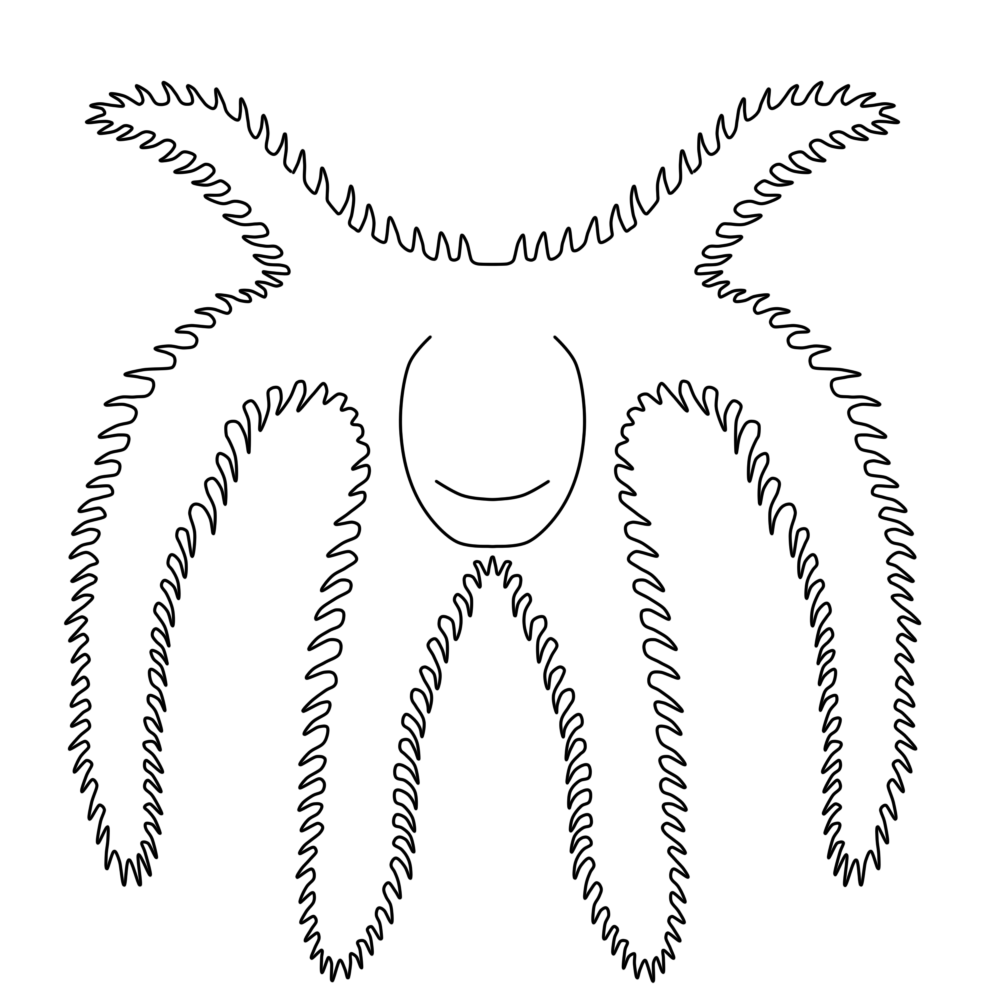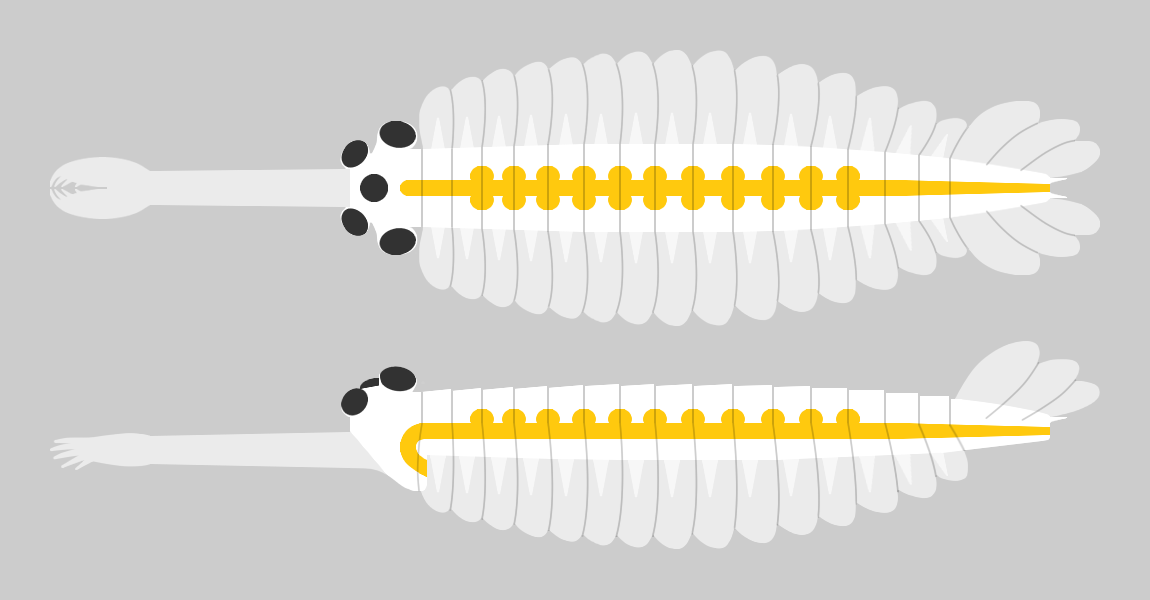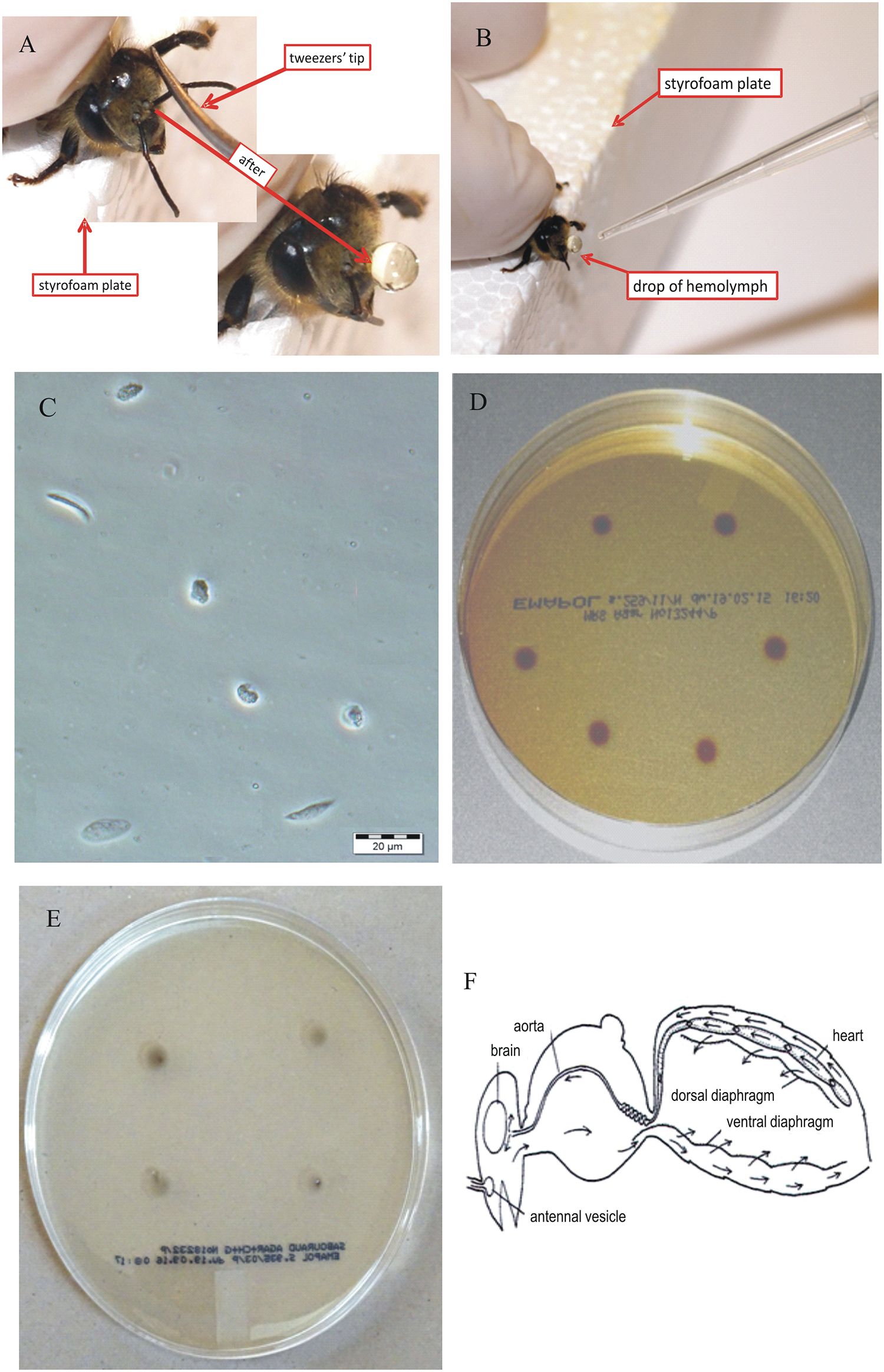|
Marrella
''Marrella'' is an extinct genus of marrellomorph arthropod known from the Middle Cambrian of North America and Asia. It is the most common animal represented in the Burgess Shale of British Columbia, Canada, with tens of thousands of specimens collected. Much rarer remains are also known from deposits in China. History ''Marrella'' was the first fossil collected by Charles Doolittle Walcott from the Burgess Shale, in 1909. Walcott described ''Marrella'' informally as a "lace crab" and described it more formally as an odd trilobite. It was later reassigned to the now defunct class Trilobitoidea in the ''Treatise on Invertebrate Paleontology''. In 1971, Whittington undertook a thorough redescription of the animal and, on the basis of its legs, gills and head appendages, concluded that it was neither a trilobite, nor a chelicerate, nor a crustacean. ''Marrella'' is one of several unique arthropod-like organisms found in the Burgess Shale. Other examples are '' Opabinia'' and ' ... [...More Info...] [...Related Items...] OR: [Wikipedia] [Google] [Baidu] |
Marrella Splendens By Haug Et Al
''Marrella'' is an extinct genus of marrellomorph arthropod known from the Middle Cambrian of North America and Asia. It is the most common animal represented in the Burgess Shale of British Columbia, Canada, with tens of thousands of specimens collected. Much rarer remains are also known from deposits in China. History ''Marrella'' was the first fossil collected by Charles Doolittle Walcott from the Burgess Shale, in 1909. Walcott described ''Marrella'' informally as a "lace crab" and described it more formally as an odd trilobite. It was later reassigned to the now defunct class Trilobitoidea in the ''Treatise on Invertebrate Paleontology''. In 1971, Whittington undertook a thorough redescription of the animal and, on the basis of its legs, gills and head appendages, concluded that it was neither a trilobite, nor a chelicerate, nor a crustacean. ''Marrella'' is one of several unique arthropod-like organisms found in the Burgess Shale. Other examples are ''Opabinia'' and ''Yo ... [...More Info...] [...Related Items...] OR: [Wikipedia] [Google] [Baidu] |
Marrellomorph
Marrellomorpha are an extinct group of arthropods known from the Cambrian to the Early Devonian. They lacked mineralised hard parts, so are only known from Lagerstätte, areas of exceptional preservation, limiting their fossil distribution. The best known member is ''Marrella'', with thousands of specimens found in the Cambrian aged Burgess Shale of Canada. Taxonomy The group is divided up into two major orders, Marrellida and Acercostraca. Marrellida is recognised by the possession of head shields with two or three pairs of elongate spine-like projections, and three attached pairs of uniramous (single-branched) appendages, while Acercostraca generally have large ovoid carapaces that cover the entire upper half of the body, and five pairs of uniramous appendages attached to the head section. Both groups have unbranched Antenna (zoology), antennae and a segmented Tagma (biology), trunk with biramous (divided into two branches) appendages. Recent research has suggested the previou ... [...More Info...] [...Related Items...] OR: [Wikipedia] [Google] [Baidu] |
Arthropod
Arthropods ( ) are invertebrates in the phylum Arthropoda. They possess an arthropod exoskeleton, exoskeleton with a cuticle made of chitin, often Mineralization (biology), mineralised with calcium carbonate, a body with differentiated (Metamerism (biology), metameric) Segmentation (biology), segments, and paired jointed appendages. In order to keep growing, they must go through stages of moulting, a process by which they shed their exoskeleton to reveal a new one. They form an extremely diverse group of up to ten million species. Haemolymph is the analogue of blood for most arthropods. An arthropod has an open circulatory system, with a body cavity called a haemocoel through which haemolymph circulates to the interior Organ (anatomy), organs. Like their exteriors, the internal organs of arthropods are generally built of repeated segments. They have ladder-like nervous systems, with paired Anatomical terms of location#Dorsal and ventral, ventral Ventral nerve cord, nerve cord ... [...More Info...] [...Related Items...] OR: [Wikipedia] [Google] [Baidu] |
Opabinia
''Opabinia regalis'' is an extinct, stem group marine arthropod found in the Middle Cambrian Burgess Shale Lagerstätte (505 million years ago) of British Columbia. ''Opabinia'' was a soft-bodied animal, measuring up to 7 cm in body length, and had a segmented trunk with flaps along its sides and a fan-shaped tail. The head showed unusual features: five eyes, a mouth under the head and facing backwards, and a clawed proboscis that most likely passed food to its mouth. ''Opabinia'' lived on the seafloor, using the proboscis to seek out small, soft food. Free abstract at Fewer than twenty good specimens have been described; 3 specimens of ''Opabinia'' are known from the Greater Phyllopod bed, where they constitute less than 0.1% of the community. When the first thorough examination of ''Opabinia'' in 1975 revealed its unusual features, it was thought to be unrelated to any known phylum, or perhaps a relative of arthropod and annelid ancestors. However, later studies since l ... [...More Info...] [...Related Items...] OR: [Wikipedia] [Google] [Baidu] |
Ecdysis
Ecdysis is the moulting of the cuticle in many invertebrates of the clade Ecdysozoa. Since the cuticle of these animals typically forms a largely inelastic exoskeleton, it is shed during growth and a new, larger covering is formed. The remnants of the old, empty exoskeleton are called exuviae. After moulting, an arthropod is described as ''teneral'', a ''callow''; it is "fresh", pale and soft-bodied. Within one or two hours, the cuticle hardens and darkens following a Tanning (leather), tanning process analogous to the production of leather. During this short phase the animal expands, since growth is otherwise constrained by the rigidity of the exoskeleton. Growth of the limbs and other parts normally covered by the hard exoskeleton is achieved by transfer of body fluids from soft parts before the new skin hardens. A spider with a small abdomen may be undernourished but more probably has recently undergone ecdysis. Some arthropods, especially large insects with tracheal respira ... [...More Info...] [...Related Items...] OR: [Wikipedia] [Google] [Baidu] |
Hemolymph
Hemolymph, or haemolymph, is a fluid, similar to the blood in invertebrates, that circulates in the inside of the arthropod's body, remaining in direct contact with the animal's tissues. It is composed of a fluid plasma in which hemolymph cells called hemocytes are dispersed. In addition to hemocytes, the plasma also contains many chemicals. It is the major tissue type of the open circulatory system characteristic of arthropods (for example, arachnids, crustaceans and insects). In addition, some non-arthropods such as mollusks possess a hemolymphatic circulatory system. Oxygen-transport systems were long thought unnecessary in insects, but ancestral and functional hemocyanin has been found in the hemolymph. Insect "blood" generally does not carry hemoglobin, although hemoglobin may be present in the tracheal system instead and play some role in respiration. Method of transport In the grasshopper, the closed portion of the system consists of tubular hearts and an ao ... [...More Info...] [...Related Items...] OR: [Wikipedia] [Google] [Baidu] |
Iridescent
Iridescence (also known as goniochromism) is the phenomenon of certain surfaces that appear gradually to change colour as the angle of view or the angle of illumination changes. Iridescence is caused by wave interference of light in microstructures or thin films. Examples of iridescence include soap bubbles, feathers, butterfly wings and seashell nacre, and minerals such as opal. Pearlescence is a related effect where some or most of the reflected light is white. The term pearlescent is used to describe certain paint finishes, usually in the automotive industry, which actually produce iridescent effects. Etymology The word ''iridescence'' is derived in part from the Greek word ἶρις ''îris'' ( gen. ἴριδος ''íridos''), meaning ''rainbow'', and is combined with the Latin suffix ''-escent'', meaning "having a tendency toward". Iris in turn derives from the goddess Iris of Greek mythology, who is the personification of the rainbow and acted as a messenger of the g ... [...More Info...] [...Related Items...] OR: [Wikipedia] [Google] [Baidu] |
Diffraction Grating
In optics, a diffraction grating is an optical grating with a periodic structure that diffraction, diffracts light, or another type of electromagnetic radiation, into several beams traveling in different directions (i.e., different diffraction angles). The emerging coloration is a form of structural coloration. The directions or diffraction angles of these beams depend on the wave (light) Angle of incidence (optics), incident angle to the diffraction grating, the spacing or periodic distance between adjacent diffracting elements (e.g., parallel slits for a transmission grating) on the grating, and the wavelength of the incident light. The grating acts as a dispersion (optics), dispersive element. Because of this, diffraction gratings are commonly used in monochromators and spectrometers, but other applications are also possible such as optical encoders for high-precision motion control and wavefront measurement. For typical applications, a reflection (optics), reflective grati ... [...More Info...] [...Related Items...] OR: [Wikipedia] [Google] [Baidu] |
Thorax (arthropod Anatomy)
The thorax is the midsection ( tagma) of the hexapod body (insects and entognathans). It holds the head, legs, wings and abdomen. It is also called mesosoma or cephalothorax in other arthropods. It is formed by the prothorax, mesothorax and metathorax and comprises the scutellum; the cervix, a membrane that separates the head from the thorax; and the pleuron, a lateral sclerite of the thorax. In dragonflies and damselflies, the mesothorax and metathorax are fused together to form the synthorax. In some insect pupae, like the mosquitoes', the head and thorax can be fused in a cephalothorax. Members of suborder Apocrita (wasps, ants and bees) in the order Hymenoptera Hymenoptera is a large order of insects, comprising the sawflies, wasps, bees, and ants. Over 150,000 living species of Hymenoptera have been described, in addition to over 2,000 extinct ones. Many of the species are parasitic. Females typi ... have the first segment of the abdomen fused with the thorax ... [...More Info...] [...Related Items...] OR: [Wikipedia] [Google] [Baidu] |
Telson
The telson () is the hindmost division of the body of an arthropod. Depending on the definition, the telson is either considered to be the final segment (biology), segment of the arthropod body, or an additional division that is not a true segment on account of not arising in the embryo from teloblast areas as other segments. It never carries any appendages, but a forked "tail" called the caudal furca may be present. The shape and composition of the telson differs between arthropod groups. Crustaceans In lobsters, Caridea, shrimp and other Decapoda, decapods, the telson, along with the uropods, forms the tail fan. This is used as a paddle in the caridoid escape reaction ("lobstering"), whereby an alarmed animal rapidly flexes its tail, causing it to dart backwards. Krill can reach speeds of over 60 cm per second by this means. The Induction period, trigger time to optical stimulus (physiology), stimulus is, in spite of the low temperatures, only 55 milliseconds. In th ... [...More Info...] [...Related Items...] OR: [Wikipedia] [Google] [Baidu] |
Exopod
The arthropod leg is a form of jointed appendage of arthropods, usually used for walking. Many of the terms used for arthropod leg segments (called podomeres) are of Latin origin, and may be confused with terms for bones: ''coxa'' (meaning hip (anatomy), hip, : ''coxae''), ''trochanter'', ''femur'' (: ''femora''), ''tibia'' (: ''tibiae''), ''tarsus'' (: ''tarsi''), ''ischium'' (: ''ischia''), ''metatarsus'', ''carpus'', ''dactylus'' (meaning finger), ''patella'' (: ''patellae''). Homology (biology), Homologies of leg segments between groups are difficult to prove and are the source of much argument. Some authors posit up to eleven segments per leg for the most recent common ancestor of Neontology, extant arthropods but modern arthropods have eight or fewer. It has been argued that the ancestral leg need not have been so complex, and that other events, such as successive loss of function of a Homeobox, ''Hox''-gene, could result in Parallel evolution, parallel gains of leg segments ... [...More Info...] [...Related Items...] OR: [Wikipedia] [Google] [Baidu] |










